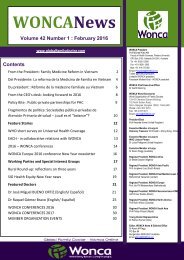You also want an ePaper? Increase the reach of your titles
YUMPU automatically turns print PDFs into web optimized ePapers that Google loves.
HEART FAILURE: ROUTINE CARE• The patient with heart failure has difficulty breathing especially on lying down/with effort as well as leg swelling. A doctor must confirm the diagnosis. DrRecognise the patient with heart failure needing urgent attention:• Respiratory rate > 30 breaths/minute• Fainting/blackouts• Irregular pulse• Temperature ≥ 38ºC• Sit patient up and give 100% oxygen via face mask to deliver 40% oxygen.• Give furosemide slowly IV. 1st dose 40mg. If respiratory rate does not improve after 30 minutes, add 80mg; if still no better after 20 minutes give another 40mg.• Give morphine IV: dilute 15mg with 14ml of water for injection or sodium chloride 0.9%. Give 1ml/min to a maximum of 5mg even if there is no pain.• Give sublingual isosorbide dinitrite 5mg. Repeat 4 hourly even if there is no pain.• Refer urgentlyAdvise the patient with heart failure• Advise patient to adhere to treatment even if asymptomatic.• Help the patient to manage his/her CVD risk 69. Advise regular exercise within limits of symptoms.• Restrict fluid intake to less than 1 litre/day if marked leg or abdominal swelling.Dr Treat the patient with heart failure• Give drugs as in table below. If symptoms not resolved after 1 month on treatment and patient is adherent, proceed to the following step:Step Drug Dose Note1 Enalapril and eitherHCTZ orfurosemideUp to 10mg twice a day25–50mg daily40–80mg dailyAssess the patient with heart failureAssess When to assess NoteSymptoms Every visit Manage symptom as on symptom page. If cough and difficult breathing 16 and refer to doctor.Pregnancy status Every visit Discuss family planning needs 91. If pregnant, refer for specialist care.Substance abuse At diagnosis > 21 drinks/week (man) or >14 drinks/week (woman) and/or > 5 drinks/session or misuse of illicit or prescription drugs 83.Weight Every visit Assess changes in fluid balance by comparing with weight when patient as asymptomatic as possible.BP Every visit If BP ≥ 130/80 73. Aim to treat hypertension to < 130/80. Avoid atenolol.Blood tests At diagnosis Check Hb, glucose, eGFR, TSH, HIV if status unknown 60.• Avoid enalapril in pregnancy, previous angioedema or renal artery stenosis. If eGFR < 60 and/or PVD, check eGFR andpotassium within 4 weeks of starting/changing dose.• Use HCTZ if mild heart failure symptoms and eGFR ≥ 60. Avoid in gout, liver, kidney disease.• Use furosemide if significant heart failure symptoms or eGFR < 60. Monitor eGFR and electrolytes.2 Add spironolactone 25mg daily Monitor serum potassium. Avoid with potassium supplements and in kidney failure.3 Add carvedilol 3.125mg twice daily. Double dose 2 weekly up to 25mg twice daily. Avoid in cardiogenic shock, severe fluid overload, BP < 90/60, asthma. Avoid or decrease dose if pulse < 60.4 Add digoxin 0.125mg daily Also refer patient for further assessment.75



